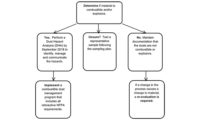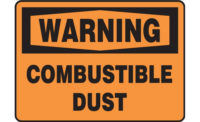Understand NFPA 652 and new requirements for a dust hazard analysis
A dangerous dust up

Due to a growing number of catastrophic fires and explosions caused by combustible dust in the last decade, OSHA has recognized combustible dust as a hazard. The presence of dust in a factory is now at the top of the list of items to inspect during an audit. The Combustible Dust National Emphasis Program issued by OSHA in 2008 instructs inspectors on how to identify combustible dust hazards. However there is evidence that many factories handling combustible dusts are unaware of the hazards. Therefore, NFPA decided to introduce a new standard to promote further awareness.
A new standard
NFPA 652: Standard on the Fundamentals of Combustible Dust, 2016 edition, has an effective date of 9/7/2015. This standard was created to promote and define hazard analysis, awareness, management and mitigation. The standard also issues a new term, Dust Hazard Analysis, or DHA, to differentiate this analysis from the more complex forms of process hazard analysis methods currently found in industry. If you have processes that create dust or use powders, then you have a responsibility to determine if you have a combustible dust hazard. NFPA 652 is the starting point for this analysis. It will guide you step by step in identifying hazards and what to do next.
The NFPA standards have required a process hazard analysis since 2005. NFPA 652 takes this requirement further by making this requirement retroactive to existing installations with a deadline. A DHA is now required for new installations and upgrades to existing installations. The standard allows three years to complete this DHA. To illustrate the importance of this hazard analysis, many OSHA citations regarding combustible dust hazards list the lack of a hazard analysis at the top of the citation.
The information presented in this article is especially important for companies that are processing, creating or handling combustible dust, and are using less complex dust collection systems. Since NFPA 652 requires all such facilities to perform a dust hazard analysis and risk assessment for each process that handles or creates combustible dust, they must complete a DHA for their dust collection system.
What is a DHA?
A Dust Hazard Analysis is a tool used to improve plant safety by identifying the specific combustible dust hazards associated with a process. For the DHA, you will review your facility and your processes so that you can determine potential risks and create a plan to minimize or mitigate those risks.
Chapter 7 of NFPA 652 provides detailed descriptions and explanations of DHAs. You can also find a complete, step-by-step example of how to create a DHA in Annex B. In addition, the Center for Chemical Process Safety publishes Guidelines for Hazard Evaluation Procedures, which covers simple and complex systems and techniques with examples. As an employer, you must take this DHA process very seriously because it will serve as your roadmap to prevent and remove the risks associated with combustible dusts.
Hazards associated with combustible dusts
You already know that the purpose of a dust collection system is to remove and isolate dust away from people who can inhale it and process areas where it could accumulate and become a deflagration hazard. The DHA will identify the following conditions that may exist external or internal to the system that contribute to a fire or deflagration hazard:
Presence of oxygen: Air is the oxidant
Presence of fuel: Combustible dust where ever it is found
- Floors
- Elevated surfaces
- Inside ducts
- Inside process enclosures and machines
Dispersion of Fuel:
- Pulse cleaning inside dust collector
- Use of compressed air for cleaning
- Events that can dislodge dust from elevated surfaces
Ignition Sources:
- Sparks
- Electrical shorts
- Hot work
- Electrostatic discharge
- Flames
- Rotating equipment
- Hot surfaces
Containment Locations:
- Inside pipes
- inside dust collectors
- Inside any process enclosure or machine
Who should perform the DHA for your dust collection system?
Ideally, your DHA will start during the dust collection system’s design phase and continue with periodic reviews and updates during its life and through its decommissioning. The complexity of the system will determine how many people should participate in the DHA. Often with nuisance dust collection systems, the DHA can be prepared by the person most familiar with the system.
More complex systems may require the help of equipment operators or maintenance personnel who have valuable insights into fixes for recurring malfunctions that might create a hazardous condition. Regardless of the complexity of the system, everyone involved in a DHA should be familiar with all the governing NFPA standards.
Documents to file
Should OSHA inspectors discover combustible dust during an inspection of your facility, the first thing they will ask for is your DHA, and they will cite you if you don’t provide it. Documenting a DHA can be as simple as a spreadsheet that lists each hazard, where it is located and what action was taken to mitigate that hazard. The analysis should classify each system segment as “not a hazard,” “possible hazard” or “deflagration hazard.”
For each system segment, you should ask the following questions:
- Is the dust combustible or exposable in this segment?
- Is the dust suspended in air?
- Is the dust concentration dense enough to support a deflagration?
- Is an ignition source strong enough to ignite the dust cloud present?
- Are any hazard management controls in place?
Timeframe for completion of DHA
Before NFPA 652, companies didn’t need to perform hazards analysis on an existing combustible dust processes unless the process was modified more than 25 percent of its initial installation cost. Now, facilities must complete a DHA no later than October, 2018. They also need to demonstrate reasonable progress toward this goal between now and then.
NFPA 652 also requires facilities to provide a program for inspection, testing and maintenance of safety-critical systems, which includes combustible dust controls. Equipment operators, maintenance personnel and others now need to be trained in dust hazard awareness and job-specific safeguards prior to working with the dust collection system.
Facility owners and operators should be aware that OSHA is progressively training officers about combustible dust hazards and adding personnel to its inspection force. Bottom line: You must now take combustible dust hazards seriously to achieve compliance, and, more importantly, to protect your workers and property.
Looking for a reprint of this article?
From high-res PDFs to custom plaques, order your copy today!






